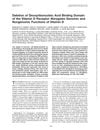TLDR Vitamin D is crucial for bone health and preventing serious diseases.
The document emphasized the critical role of vitamin D in patients receiving parenteral nutrition (PN), highlighting its importance in bone health, immune modulation, and disease prevention. It discussed the necessity of maintaining adequate serum 25-hydroxyvitamin D3 levels (30-100 ng/ml) to prevent conditions like osteoporosis, osteomalacia, and secondary hyperparathyroidism. The document also noted the insufficiency of current intravenous vitamin D preparations and recommended the development of parenteral solutions. It underscored the complexity of metabolic bone disease in long-term PN patients, suggesting that factors beyond vitamin D deficiency contribute to these conditions and require further investigation.
29 citations
,
January 2003 in “KARGER eBooks” HVDRR is caused by VDR gene mutations, leading to vitamin D resistance, treatable with high calcium doses, but alopecia remains permanent.
88 citations
,
October 1983 in “The Journal of clinical endocrinology and metabolism/Journal of clinical endocrinology & metabolism” Patients with this syndrome can have different responses and worsening resistance to treatment over time.
51 citations
,
September 2008 in “Journal of Investigative Dermatology” Vitamin D receptor may help protect against UV-induced skin cancer.
78 citations
,
November 2005 in “Endocrinology” Hairless protein can block vitamin D activation in skin cells.
 9 citations
,
January 2005 in “Experimental dermatology”
9 citations
,
January 2005 in “Experimental dermatology” Melatonin receptors in hair follicles help regulate hair growth and could treat hair loss.
 277 citations
,
July 2002 in “Molecular Endocrinology”
277 citations
,
July 2002 in “Molecular Endocrinology” Removing part of the vitamin D receptor stops vitamin D from working properly.
15 citations
,
March 2000 in “The journal of investigative dermatology/Journal of investigative dermatology” As skin cells mature, vitamin D receptor levels decrease while retinoid X receptor α levels increase.
36 citations
,
February 2007 in “Journal of biological chemistry/The Journal of biological chemistry” The vitamin D receptor can work without its usual activating molecule.

